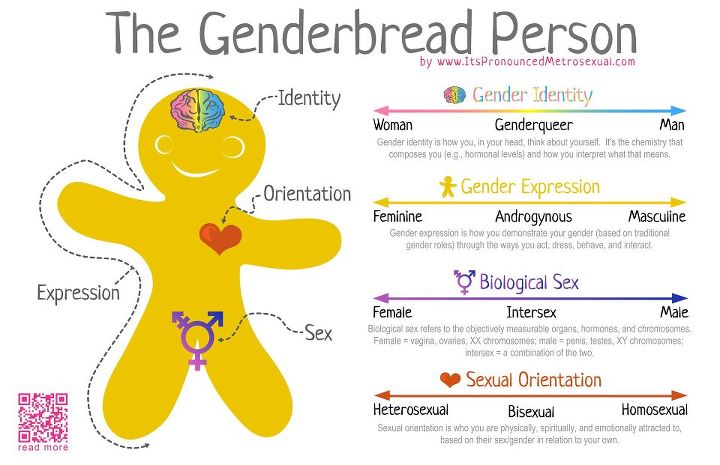|
“First they came for the communists, and I did not speak out-- because I was not a communist; Then they came for the socialists, and I did not speak out-- because I was not a socialist; Then they came for the trade unionists, and I did not speak out-- because I was not a trade unionist; Then they came for the Jews, and I did not speak out-- because I was not a Jew; Then they came for me-- and there was no one left to speak out for me.” -Martin Niemoller What do you think?STOCKHOLM — At an ocher-color preschool along a lane in Stockholm’s Old Town, the teachers avoid the pronouns “him” and “her,” instead calling their 115 toddlers simply “friends.” Masculine and feminine references are taboo, often replaced by the pronoun “hen,” an artificial and genderless word that most Swedes avoid but is popular in some gay and feminist circles. In the little library, with its throw pillows where children sit to be read to, there are few classic fairy tales, like “Cinderella” or “Snow White,” with their heavy male and female stereotypes, but there are many stories that deal with single parents, adopted children or same-sex couples. Girls are not urged to play with toy kitchens, and wooden or Lego blocks are not considered toys for boys. And when boys hurt themselves, teachers are taught to give them every bit as much comforting as they would girls. Everyone gets to play with dolls; most are anatomically correct, and some are also black. Sweden is perhaps as renowned for an egalitarian mind-set as it is for meatballs or Ikea furnishings. But this taxpayer-financed preschool, known as the Nicolaigarden for a saint whose chapel was once in the 300-year-old building that houses it, is perhaps one of the more compelling examples of the country’s efforts to blur gender lines and, theoretically, cement opportunities for both women and men. What the children are taught, said Malin Engleson, an art gallery employee, as she fetched her 15-month-old daughter Hanna from the school, “shows that girls can cry, but boys too.” “That’s why we chose it,” she said. “It’s so important to start at an early age.” The model has been so successful that two years ago three of its teachers opened an offshoot, which now has almost 40 children. That school, named Egalia to suggest equality, is in a 1960s housing project in the Sodermalm neighborhood. What has become a passionate undertaking for its teachers actually began with a nudge from Swedish legislators, who in 1998 passed a bill requiring that schools, including day care centers, assure equal opportunities for girls and boys. Spurred by the law, the teachers at Nicolaigarden took the unusual step of filming one another, capturing their behavior while playing with, eating with or just being with the center’s infants to 6-year-olds. “We could see lots of differences, for example, in the handling of boys and girls,” said Lotta Rajalin, who directs the center and three others, which she visits by bicycle. “If a boy was crying because he hurt himself, he was consoled, but for a shorter time, while girls were held and soothed much longer,” she said. “With a boy it was, ‘Go on, it’s not so bad!’ ” The filming, she said, also showed that staff members tended to talk more with girls than with boys, perhaps explaining girls’ later superior language skills. If boys were boisterous, that was accepted, Ms. Rajalin said; a girl trying to climb a tree on an outing in the country was stopped. The result, after much discussion, was a seven-point program to alter such behavior. “We avoid using words like boy or girl, not because it’s bad, but because they represent stereotypes,” said Ms. Rajalin, 53. “We just use the name — Peter, Sally — or ‘Come on, friends!’ ” Men were added to the all-female staff. With Egalia, Nicolaigarden sought and obtained certification from an organization for gay and bisexual people that its staff is sensitive to their problems. Criticism was not long in arriving. “There are a lot of letters, mail, blogs,” Ms. Rajalin said. “But it’s not so much arguments; it’s anger, basically.” A persistent critic has been Tanja Bergkvist, a mathematician at Uppsala University whose blog consistently attacks Sweden’s “gender madness.” In an article for the newspaper Svenska Dagbladet, she questioned whether children were not being “brainwashed by our parents already at the age of 3 months.” On outings, she mocked, “what do they do when a girl is picking flowers, while a boy collects rocks?” Such criticism, said Carl-Johan Norrman, 36, who has worked at Nicolaigarden for 18 months, “starts from misconceptions: we want to turn little boys into little girls. It’s a whispering game that snowballs.” Despite such gibes, others see the efforts as somehow peculiarly Nordic, and admirable. “I think it’s quite Swedish, it’s good,” said Camilla Flodin, 29, a native of London who has lived in Stockholm for two and a half years. Her boyfriend’s sister gets annoyed, she said, if you give her daughter a gift that is overly feminine. Peter Rudberg, 36, an anesthesiologist whose 3-year-old son, Hjalmar, attends the kindergarten, called its gender-neutral approach “a boon,” though, like many Swedes, he believes the country has moved beyond the problem. “In modern Sweden, gender equality is a nonissue,” he said. Yet he cautioned against extremes, like “boys prohibited from playing boys’ games.” At Stockholm’s immense brick town hall, the moderate-conservative coalition governmentfully supports the gender policy. “The important thing is that children, regardless of their sex, have the same opportunities,” said Lotta Edholm, the deputy mayor responsible for schools. “It’s a question of freedom.” On the other hand, she said, parents will always play a larger role in children’s development than day care or school. “Preschool is a couple of hours a day,” said Ms. Edholm, who has a 16-year-old son. “Most of the time, children are with their parents, and the values parents impart to their children tend to be the values they adopt.” As the Christmas season approaches, Swedes are preparing for the Feast of Lucia, on Dec. 13, when children march in processions accompanying St. Lucia, traditionally portrayed by a teenage girl in white robes and crowned with a wreath of lighted candles. Could a boy now portray Lucia? In fact, Ms. Edholm said, in recent years in a town outside Stockholm a teenage boy did seek the role, but was refused. Evidently, she said, women in modern Sweden can more readily slip into male roles than vice versa. “The interesting thing is that it’s not a problem for a girl to be Santa Claus,” she said. “But it is a problem for a boy to be Lucia.”
SOURCE: NEW YORK TIMES
 Sourcer: hellogiggles.com On her third day at Oakleaf High School in Orange Park, Florida, Miranda Larkin was stopped by a teacher and sent to the nurse’s office. Once there, she was told to change out of the clothes she wore to school that day and put on the “dress-code-violation outfit.” Miranda was forced to wear the outfit—which consists of a neon yellow t-shirt with “DRESS CODE VIOLATION” printed across the front in big block letters and a pair off red sweatpants with the same message running down the leg—after wearing a skirt that didn’t reach her knees, violating the school’s dress code. “The school has said, ‘This is to embarrass you,’” Miranda told ABC News. “It’s supposed to embarrass you so you don’t do it again,” she said. “I got really upset and asked if I could call my mom. She was really upset, as well.” In Miranda’s mom, Dianna’s mind, the school’s actions were tantamount to bullying. “She’s a good kid,” Dianna told ABC. “She actually has a perfect disciplinary record. I’m not a rescue mom. I really do believe in punishing my kids if they do something wrong, but this is not about punishing kids. This is about humiliation.” In a statement to ABC News affiliate WJXX in Jacksonville, Florida, a school spokesperson stated that students who violate the dress code (skirts must be knee-length or longer) are given the options to stay in their clothes and have someone bring them a new outfit, serve suspension time or wear what’s being dubbed by media outlets as a “shame suit.” Miranda claims she wasn’t given any alternate options, according to ABC News. Dress codes are, generally speaking, largely arbitrary. One school might require that skirts reach your kneecaps, while another might say that anything beyond the edges of someone’s arms at side fingertips meets code. One might have a “no cleavage” rule, while another might use arbitrary markers such as finger widths, palms, or some other odd unit of measurement to determine how low one’s top can be. Dress codes are disproportionately aimed at curbing young women from expressing themselves freely, and in their creation, often cite fears of distracted male students as their rationale. Dress codes are often one of the first firm examples of body-shaming that young women face. Rather than instill a culture of respect, schools so very often tell these young women that it is their responsibility to not do something a male student might find distracting. In turn, this encourages a “boys will be boys” cultre in which boys are provided excuses for ogling or otherwise sexually harassing their female classmates without repercussion. Miranda had only moved to the area eight days before class began. She didn’t know that her skirt violated the school’s code. The puninshment doled out by the school served as the most public shaming of all — a scarlett letter, a cautionary tale, and a reminder that how a woman expresses herself through clothing or makeup will forever be used to blame her for the actions of someone else. If there’s ever to be hope that the world will no longer be so fueled by sexism, society needs to start breaking down these walls. Rather than developing and enforcing sexist dress codes for fear of someone being distracted, address those distracted. Someone’s existence—which includes their personality, their body, their intelligence, and yes, the way they express themselves in terms of fashion—cannot, in itself, be distracting. Let’s strive for a world where girls don’t have to curb who they are.
|
ForumPart of your mark comes from fair and respectful participation in online forums. Please respond to as many of these topics as you can. Show respect, be detailed and never make a statement you don't back up. Archives
November 2014
Categories
All
|

 RSS Feed
RSS Feed